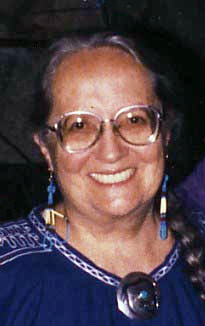Felicitas Goodman
Felicitas D. Goodman (born Daniels; born January 30, 1914 in Budapest , Hungary; † March 30, 2005 in Columbus (Ohio) , USA) was a cultural anthropologist , trance researcher and writer. She taught at Denison University in Columbus (Ohio) until 1978. In 1979 she founded the international Cuyamungue Institute in New Mexico for the research and teaching of ritual postures and ecstatic trance.
Life
Felicitas D. Goodman was born in Budapest in 1914. She spent her childhood as a German-born Hungarian in Hungary, Romania and Germany. In 1931 her family was expelled from Transylvania. From 1931 to 1934 Goodman studied at the University of Heidelberg. She completed her studies as a qualified interpreter for the English language. In 1947 she moved with her family to the USA and worked as a translator and private lecturer. She studied linguistics and cultural anthropology at the University of Ohio and graduated with a diploma in linguistics and a doctorate in cultural anthropology. She then taught as a professor of linguistics, ethnology and cultural anthropology at Denison University.
plant
At Denison University, Goodman and her teacher, Erika Bourguignon, began a seventeen year research project on women in a Pentecostal church in a village in Yucatan, Mexico. A monograph on this fieldwork, 17 Years with the Women of a Maya Village , appeared in 1999.
Based on her research on speaking in tongues in Pentecostal churches, Goodman dealt in 1977 with her further research on language, rhythm and trance states with prehistoric statuettes and images in cave paintings that show conspicuous postures. Inspired by the illustration of a Sámi beating a shaman's drum , she examined the rapid rattle rhythm of 210 bpm of the grain dances of the pueblo peoples of New Mexico. She assumed connections between rituals of many indigenous peoples and certain shamanic postures when rhythmically stimulated by drums or rattles.
Goodman came to the conclusion that the state of consciousness changes markedly if one reproduces one of the relevant postures with the rhythmic stimulation of 210 bpm. In this way trance can be brought about. In this state, with the involvement of all senses, a visionary experience is possible that is comparable to the visionary journeys of the shamans. In the state of trance experience, the biochemical body balance is greatly changed. The experience could culminate in the sensation of “boiling energy”.
In 1979, Goodman founded the Cuyamungue Institute near Santa Fe, New Mexico, for the study and teaching of ritual postures and ecstatic trance. She published her results in journals, books, lectures at universities, congresses and workshops.
Individuals in Germany have come together under the name Felicitas Goodman Institute to offer alternative practitioner services, psychological and spiritual advice.
Fonts
- Anneliese Michel and her demons. The Klingenberg case from a scientific perspective. 2nd Edition. Christiana-Verlag , Stein am Rhein 1987, ISBN 3-7171-0781-X
- Ecstasy, obsession, demons - the mysterious side of religion , (1991), Gütersloher Verlagshaus, ISBN 978-3-579-00282-8
- Trance. The Ancient Path to Religious Experience (1992); Gütersloher publishing house; Edition: 5 (2003), ISBN 978-3-579-00969-8
- Where the spirits ride the winds (1993, 2007); Published by Binkey Kok, Neuaufl. (2007), ISBN 978-90-78302-19-3
- My last 40 days. An Indian vision about dying and death , Walter-Verlag (March 2001), ISBN 978-3-530-50005-9
- The Other Reality - About the Religious in the Cultures of the World , (1994); ISBN 978-3-87294-989-9
- The Blue Bridge - Fairy Tales (1945, 1999); Published by Schwerdtfeger (1945); Publisher: Binkey Kok (1999), ISBN 978-3-933467-03-4
- Ecstatic trance - the workbook (in collaboration with Nana Nauwald and friends, 2004); Verlag Binkey Kok, expanded and updated new edition (2007), ISBN 978-90-74597-81-4
Web links
- Literature by and about Felicitas Goodman in the catalog of the German National Library
Individual evidence
| personal data | |
|---|---|
| SURNAME | Goodman, Felicitas |
| ALTERNATIVE NAMES | Goodman, Felicitas D .; Daniels, Felicitas (maiden name) |
| BRIEF DESCRIPTION | American ethnologist, shamanism, ecstasy and trance researcher |
| DATE OF BIRTH | January 30, 1914 |
| PLACE OF BIRTH | Budapest , Hungary |
| DATE OF DEATH | March 30, 2005 |
| Place of death | Columbus (Ohio) , USA |
